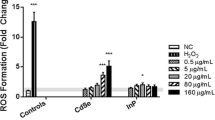Abstract
The recent increase in understanding of cell death has promoted new approaches in toxicological studies, mainly those dealing within vitro systems where the evaluation of cell death has been the most widely adopted end-point in measuring the effects of chemical toxicants. The aim of this study was to investigate the possibility of improving the traditional cytotoxicity test protocols in order to produce more specific information on the type of cell death induced by exposure to toxicants. In particular, we characterized the mode of cell death in an established epithelial cell line, HEp-2 cells, which is frequently used in cytotoxicity testing owing to its easy handling and standardization of culture conditions. Reference chemicals for apoptosis and necrosis were selected as controls, together with other molecules that have been shown, in preliminary studies, to induce various morphological and structural modifications in relation to cell death. The results obtained show that: (a) the floating fraction of treated cells gives the clearest picture of the necrotic/apoptotic distribution; (b) morphological analysis is crucial for characterization of apoptosis; (c) more than one cytotoxic end-point is necessary to clearly identify the type of cell death.
Similar content being viewed by others
References
Allen RT, Hunter WJ, Agrawal DK. Morphological and biochemical characterisation and analysis of apoptosis. J Pharmacol Toxicol Methods. 1997;37: 215-28.
Arends MJ, Wyllie AH. Apoptosis: mechanisms and roles in pathology. Int Rev Exp Pathol. 1991;32:223-54.
Borenfreund E, Puerner JA. Toxicity determined in vitro by morphological alterations and neutral red absorption. Toxicol Lett. 1985;24:119-24.
Corcoran GB, Ray SD. Contemporary issues in toxicology. The role of the nucleus and other compartments in toxic cell death produced by alkylating hepatotoxicants. Toxicol Appl Pharmacol. 1992;113:167-83.
Dabrowska MI, Becks LL, Lelli JL, Levee MG, Hinshaw DB. Sulfur mustard induces apoptosis and necrosis in endothelial cells. Toxicol Appl Pharmacol. 1996;141:568-83.
Dive C, Hickman JA. Drug-target interactions: only the first step in the commitment to a programmed cell death? Br J Cancer 1991;64:192-6.
Eastman A. Apoptosis: a product of programmed and unprogrammed cell death. Toxicol Appl Pharmacol. 1993;121: 160-4.
Fawthrop DJ, Boobis AR, Davies DS. Mechanisms of cell death. Arch Toxicol. 1991;65:437-44.
Hagan MP, Hopcia KL, Sylvester FC, Held KD. Caffeine-induced apoptosis reveals a persistent lesion after treatment with bromodeoxyuridine and ultraviolet-B light. Radiat Res. 1997;147:674-9.
Hammond AH, Fry JR. Involvement of cytochrome P450 2E1 in the toxicity of dichloropropanol to rat hepatocyte cultures. Toxicology. 1997;118:171-9.
Lennon SV, Martin SJ, Cotter TG. Dose-dependent induction of apoptosis in human tumour cell lines by widely diverging stimuli. Cell Prolif. 1991;24:203-14.
Lieberthal W, Triaca V, Levine J. Mechanisms of death induced by cisplatin in proximal tubular epithelial cells: apoptosis vs. necrosis. Am J Physiol. 1996;270:F700-8.
Lowry OH, Rosebrough NJ, Farr AL, Randall RL. Protein measurement with the Folin phenol reagent. J Biol Chem. 1951;193:265-75.
Lullmann-Rauch R, Pods R, von Witzendorff B. The antimalarials quinacrine and chloroquine induce weak lysosomal storage of sulphate glycosaminoglycans in cell culture and in vivo. Toxicology. 1996;110:27-37.
McConkey DJ, Orrenius S. Signal transduction pathways in apoptosis. Stem Cells. 1996;14:619-31.
Moore AE, Sabachewsky L, Wallace Toolan H. Characteristics of four permanent lines of human cancer. Cancer Res. 1955; 15:598-602.
Negri C, Donzelli M, Bernardi R, Rossi L, Burkle A, Scovassi AI. Multiparametric staining to identify apoptotic human cells. Exp Cell Res. 1997;234:174-7.
Renvoizé C, Biola A, Pallardy M, Bréard J. Apoptosis: identification of dying cells. Cell Biol Toxicol. 1998;14:111-20.
Ruoslahti E, Reed JC. Anchorage dependence, integrins, and apoptosis. Cell. 1994;77:477-8.
Sarich TC, Youssefi M, Zhou T, Adams SP, Wall RA, Wright JM. Role of hydrazine in the mechanisms of isoniazid hepatotoxicity in rabbits. Arch Toxicol. 1996;70:835-40.
Sarich TC, Adams SP, Zhou T, Wright JM. Isoniazid-induced hepatic necrosis and steatosis in rabbits: absence of effect of gender. Can J Physiol Pharmacol. 1997;75:1108-11.
Takahashi M, Yamamoto Y, Hatori S, et al. Enhancement of CDDP cytotoxicity by caffeine is characterised by apoptotic cell death. Oncol Rep. 1998;5:53-6.
Toimela T, Tahti H, Salminen L. Retinal pigment epithelium cell culture as a model for evaluation of the toxicity of tamoxifen and chloroquine. Ophthal Res. 1995;27:150-3.
van den Dobbelsteen DJ, Orrenius S, Slater AFG. Environmental toxicants and apoptosis. Comments Toxicol. 1997;6: 511-28.
Wang X, Ohno T. Typing of MEIC chemicals according to their toxicokinetic modes of action by lactate dehydrogenase-release assay. In Vitro Toxicol. 1995;8:55-63.
Wyllie AH. Apoptosis and carcinogenesis. Eur J Cell Biol. 1997;73:189-97.
Zanetti C, Stammati A, Sapora O, Zucco F. The human leukemic HL-60 cell line: an in vitro model for cell death endpoint identification. ATLA. 1996;24:581-7.
Zucco F. Closing the gap between cell death and in vitro toxicity testing. In: van Zutphen LFM and Balls M, eds. Animal alternatives, welfare and ethics. Amsterdam: Elsevier; 1997: 541-8. (Developments in animal and veterinary sciences, 27).
Zucco F, De Angelis I, Stammati A. Cellular models for in vitro toxicity testing. In: Clynes M, ed. Animal cell culture techniques. Heidelberg: Springer; 1998:395-422.
Rights and permissions
About this article
Cite this article
Turco, L., De Angelis, I., Stammati, A. et al. Apoptosis evaluation in epithelial cells exposed to different chemicals: relevance of floating cells. Cell Biol Toxicol 16, 53–62 (2000). https://doi.org/10.1023/A:1007696604725
Issue Date:
DOI: https://doi.org/10.1023/A:1007696604725




